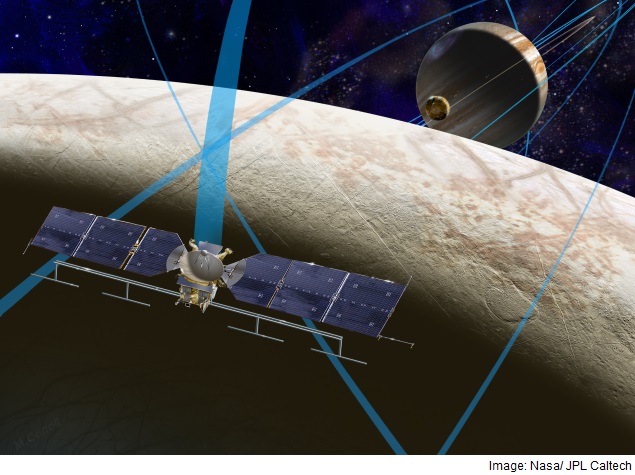- Home
- Science
- Science News
- Nasa Selects Celestial Toolbox Bound for Jupiter's Moon Europa
Nasa Selects Celestial Toolbox Bound for Jupiter's Moon Europa

The nine gadgets from cameras to radars to magnetic field gauges will be used to try to determine if Europa has an ocean beneath its glacial surface, as scientists have long suspected.
Europa, which is about the size of Earth's moon, could have twice the amount of water as our own planet, Nasa said.
Scientists are keen to find out for sure, and the nine devices will be sent to Europa sometime in the 2020s.
"We're excited about the potential of this new mission and these instruments to unravel the mysteries of Europa in our quest to find evidence of life beyond Earth," said John Grunsfeld, associate administrator for Nasa's Science Mission Directorate.
The instruments will be looking for a few key indicators to suggest Europa can in fact support life: salt water, a rocky sea floor, and energy and chemistry created by tidal heating.
"Europa could be the best place in the solar system to look for present day life beyond our home planet," Nasa said.
The mission to Europa could come with a $30 million price tag, which the space agency has already requested in its 2016 budget.
The fact-finding trip would entail sending a spacecraft to Jupiter's moon, which would orbit Europa, getting as close as 16 miles from its icy surface at times.
Among the instruments in the celestial treasure chest are cameras and spectrometers to photograph the moon.
Another device, the appropriately named magnetometer, will measure the strength and direction of Europa's magnetic field, while penetrating radars will search for subsurface lakes, much like the ones beneath Antarctica on Earth.
Other instruments will search for recent eruptions of warm water and tiny particles.
The mission will also be on the look-out for water plumes from a subsurface ocean, which will help scientists study Europa's chemical makeup key to unlocking whether its environment could support life.
Nasa scientist Curt Niebur said choosing the devices to send to Europa was a key step in the search for life on one of Jupiter's largest moons.
"This is a giant step in our search for oases that could support life in our own celestial backyard," said Niebur, Europa program scientist
"We're confident that this versatile set of science instruments will produce exciting discoveries on a much-anticipated mission."
The nine instruments were selected out of 33 proposed devices from Nasa researchers last year.
Jupiter is a gas giant, composed mainly of hydrogen and helium, and is the largest planet in the solar system.
Its four biggest moons, Ganymede, Io, Europa and Callisto, can be seen with binoculars on a clear night.
Catch the latest from the Consumer Electronics Show on Gadgets 360, at our CES 2026 hub.
Related Stories
- Samsung Galaxy Unpacked 2025
- ChatGPT
- Redmi Note 14 Pro+
- iPhone 16
- Apple Vision Pro
- Oneplus 12
- OnePlus Nord CE 3 Lite 5G
- iPhone 13
- Xiaomi 14 Pro
- Oppo Find N3
- Tecno Spark Go (2023)
- Realme V30
- Best Phones Under 25000
- Samsung Galaxy S24 Series
- Cryptocurrency
- iQoo 12
- Samsung Galaxy S24 Ultra
- Giottus
- Samsung Galaxy Z Flip 5
- Apple 'Scary Fast'
- Housefull 5
- GoPro Hero 12 Black Review
- Invincible Season 2
- JioGlass
- HD Ready TV
- Laptop Under 50000
- Smartwatch Under 10000
- Latest Mobile Phones
- Compare Phones
- OPPO Reno 15 Pro Max
- Honor Win RT
- Honor Win
- Xiaomi 17 Ultra Leica Edition
- Xiaomi 17 Ultra
- Huawei Nova 15
- Huawei Nova 15 Pro
- Huawei Nova 15 Ultra
- Asus ProArt P16
- MacBook Pro 14-inch (M5, 2025)
- OPPO Pad Air 5
- Huawei MatePad 11.5 (2026)
- Xiaomi Watch 5
- Huawei Watch 10th Anniversary Edition
- Acerpure Nitro Z Series 100-inch QLED TV
- Samsung 43 Inch LED Ultra HD (4K) Smart TV (UA43UE81AFULXL)
- Asus ROG Ally
- Nintendo Switch Lite
- Haier 1.6 Ton 5 Star Inverter Split AC (HSU19G-MZAID5BN-INV)
- Haier 1.6 Ton 5 Star Inverter Split AC (HSU19G-MZAIM5BN-INV)

















